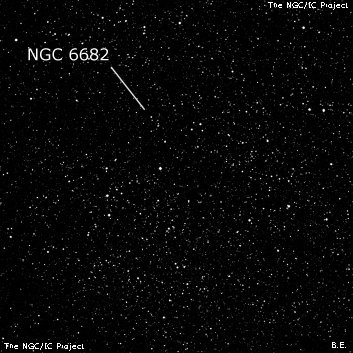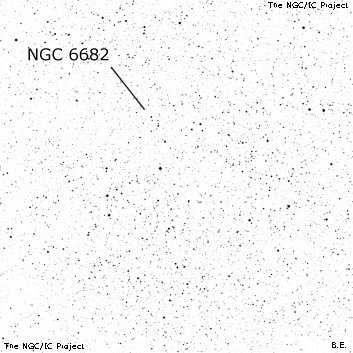NGC/IC Project Restoration Effort
(This is a very very beta version)
NGC6682


Basic Information
Location and Magnitude
Right Ascension: 18:39:37.0
Declination: -4:48:48
Constellation: SCT
Visual Magnitude:
Historic Information
Discoverer: Herschel J.
Year of discovery: 1827
Discovery aperture: 18.3
Observational
Summary description: Cl, L, Ri, st 10…18
Sub-type: *Cloud
Corwin's Notes
=====
NGC 6682. Bigourdan was the first to notice that JH's RA is 2 minutes too
large. Alister Ling picked up the error independently a century later. With
an additional small correction in Dec (about 3 arcmin to the south), JH's
"A large, pretty rich cluster of straggling stars ..." is found to be
located in a Milky Way star cloud. The remainder of his description "...
having a vacuity in the middle and broken into 2 or 3 clusters. Fills field.
70 or 80 stars of all magnitudes from 10 to 18 counted. Extended in parallel.
The most compressed part following," is accurate.
Unfortunately, the sweep is on one of the Herschel Archive left-hand pages
that is too faint to read. The reduction page on the right shows the position
that JH published in his 1833 catalogue, so we are no further ahead in trying
to understand JH's mistake.
Archinal and Hynes adopt a position similar to the one I've used, but make the
diameter 47 (!) arcminutes. Unfortunately, they have no notes on the object,
but Archinal, in his Webb Society Monograph, has a discussion where he seems
to conclude that this is a star cloud, but gives little data beyond the
position.
Steve's Notes
=====
NGC 6682
17.5" (8/12/01): this appears to be a large Milky Way field in the Scutum Star Cloud, at the eastern edge of the great rift. At 64x (31 Nagler), there is no obvious cluster but two large, fairly rich, elongated condensations were noted. The larger southern group is about 20' in size, extended NW-SE. Connected on the following end to the north is another Milky Way patch, perhaps 15' in size. Both groups are fairly rich with a background of haze. The star density dramatically drops just east of this cloud (part of Great Rift) and then the Milky Way bursts into view again on the opposite side of the rift. So the grouping only barely stands out due to location in an absorption hole at edge of the Great Rift. Listed as a nonexistent cluster in the RNGC.



